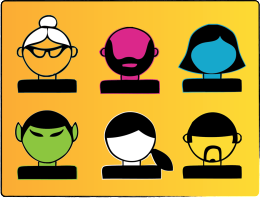 I saved the best for last. If you’ve been reading this Effective Communication series, and for whatever reason you only have room in your brain for one of the five tips, this is the one to keep: change your perspective. This sets great communicators apart from good communicators. The very best leaders and managers display this trait.
I saved the best for last. If you’ve been reading this Effective Communication series, and for whatever reason you only have room in your brain for one of the five tips, this is the one to keep: change your perspective. This sets great communicators apart from good communicators. The very best leaders and managers display this trait.
Poor communicators use themselves as their standard for speaking. When they talk, they say what they want to say as if they were their own audience. They wrap the message around their own perspective, and their true audience is forced to decode and interpret a difficult message that often ends up distorted. This video really hits the nail on the head when it comes to this idea:
Great communicators cater their message to the audience. That perspective shift ensures the message will be received how the sender intended. It sounds simple enough, but it takes some work.
Rudy Juliani understood the importance of changing your perspective. In 1994, a Republican, was able to win two consecutive Mayoral campaigns. Much of his success was attributed to Frank Luntz, the wordsmith behind his campaigns. When asked about the campaigns, Luntz observed,“It’s not what people say, it’s what people hear.” Giuliani was able to win in New York because he focused on what people heard, not just on what he said.
1. Know your audience.
If you don’t know who you’re addressing, you’ll never be able to see from their perspective.
- Gender: This may or may not seem obvious, but it is important. Males and females communicate differently – males tend to filter messages with logic first, and females tend to filter with emotion first.
- Age: We generally break audiences down into Baby Boomers, Generation X, and Millennials. These generations have grown up in different environments, and each has a different perspective. Each generation prefers different channels. Baby Boomers love to use the phone, and Millennials love texting. If you’re a Millennial who begins texting a Baby Boomer about an important issue, your message is bound to have less impact than if you’d picked the up the phone and called them.
- Personality: Introverts, extroverts, motivated by fun or by relationships, etc. If you’re in a team or group, you might think about taking a personality test with the group so you can better understand each other. Myers-Briggs and the Color Code are both great choices.
- Culture: Culture can vary widely across national borders, and if you’re in an international audience and don’t understand the culture, your message is in dire trouble. Do your research.
- Position in the company: Engineers may love talking about the minute details of how the machine’s torque coefficient has reached the nominal x-factor of 0.35 due to frictional scoring, but the company owner would probably appreciate a more general overview: a new part is required.
 Changing your perspective is a two-way street. It applies to the Receiver just as much as it does to the Sender. An effective audience will understand the perspective of the speaker and interpret what they’re hearing through that lens. Learn to consider another’s perspective during every communication, and you’ll become better not only at delivering messages, but at understanding and interpreting them.
Changing your perspective is a two-way street. It applies to the Receiver just as much as it does to the Sender. An effective audience will understand the perspective of the speaker and interpret what they’re hearing through that lens. Learn to consider another’s perspective during every communication, and you’ll become better not only at delivering messages, but at understanding and interpreting them.
2. Know your context
There are five types that you’ll need to learn to think about during any communication:
- Physical context: Location, temperature, time constraints, etc.
- Relational context: How close is our relationship? What kind of relationship is it?
- Preexisting knowledge: How much does the audience already know about the subject?
- Internal context: Thoughts or feelings like hunger, exhaustion, boredom, etc.
- Situational context: What would the other person label the event? Official meeting, casual conversation? Date, or just friends?
It’s easy to become lazy and just make assumptions instead of examining each of these aspects of context. We can’t just consider the relationships or look at only our audience’s preexisting knowledge before we start speaking. Great leaders become great because they’ve learned to intuitively gauge context in any communicative situation, and their audience appreciates and responds to that.
And that’s it. The most important communication tip I can give you, boils down to knowing your audience and knowing your context. Change your perspective and, like Rudy Giuliani, you, too, will be able to become New York City’s mayor.*
*This may or may not be true
About the author

